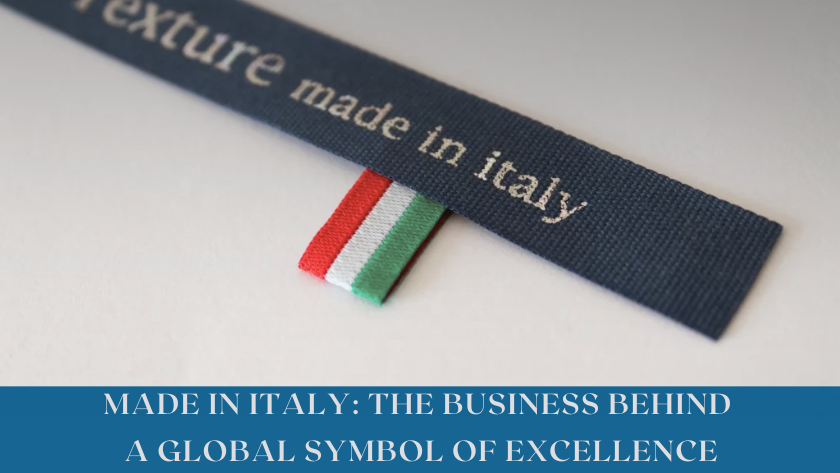Made in Italy: The Business Behind a Global Symbol of Excellence
- 25 July 2025
- Posted by: Narissra Ramangkool
- Category: News

In every stitch, every flavor, every design—Italy signs its name.
“Made in Italy” is far more than a simple label—it is one of the world’s most recognized and powerful country brands, synonymous with quality, craftsmanship, and innovation. Rooted in centuries of artisanal tradition and cultural heritage. Made in Italy today represents a multi-billion euro economic engine that drives the success of key sectors such as fashion, luxury goods, design, food, and cosmetics.
The Origins of Made in Italy
The roots of Made in Italy date back to the Renaissance, the era where Italy emerged as a global center of art, culture, and craftsmanship. Over the centuries, Italian artisans developed unmatched skills in textiles, leatherwork, ceramics, and metalwork, establishing a reputation for excellence, precision and attention to detail.
The term “Made in Italy” itself gained legal recognition in the 1980s as a response to increasing counterfeiting and the need to protect Italy’s valuable export identity. Since then, it has evolved from a mark of origin to a strategic business asset symbolizing quality, authenticity, and style.
Italy’s international distinctiveness across four key traditional sectors: fashion, food, furniture, and mechanical engineering which includes automobiles, industrial design, machinery, and shipbuilding. In Italian, these pillars of excellence are commonly referred to as the “Four A’s”:
- Abbigliamento (clothing)
- Agroalimentare (food)
- Arredamento (furniture)
- Automobili (automobiles).
Made in Italy by the Numbers
The economic impact of Made in Italy is immense. According to the latest data from the Italian Institute for Foreign Trade (ICE) and Confindustria, Made in Italy exports exceeded €500 billion in 2023, representing approximately 30% of Italy’s total exports. The sectors leading this charge include:

- Fashion and Luxury Goods: Accounting for nearly €95 billion in exports, Italian fashion brands are globally celebrated for their design, quality, and innovation. Italy ranks as the world’s third-largest exporter of fashion products.
- Food and Wine: The Italian agri-food sector exported €54 billion worth of products in 2023, fueled by global demand for authentic Italian culinary products such as olive oil, pasta, cheese, and wine.

- Furniture and Design: With a turnover of over €35 billion, Italy remains a global leader in furniture and interior design, combining craftsmanship with cutting-edge technology.
- Cosmetics and Personal Care: Italy’s cosmetics industry generated €12 billion in exports, with a consistent annual growth rate of 5% over the past five years, driven by innovation and the global prestige of Made in Italy beauty products.
The Business Strategy Behind the Brand
Made in Italy’s success is not accidental but the result of deliberate strategic positioning that combines tradition with modernity:
- Quality Control and Certification: Italy has implemented strict controls and certification systems to guarantee authenticity and product excellence, which is crucial in combating counterfeits that cost the Italian economy an estimated €15 billion annually.
- SMEs and Artisanal Networks: Italy’s economic fabric is characterized by thousands of small and medium-sized enterprises (SMEs) and artisan workshops that preserve traditional manufacturing techniques while embracing innovation and digitalization.
- Global Marketing and Diplomacy: Italian institutions and industry associations actively promote the Made in Italy brand internationally through trade fairs, cultural events, and bilateral agreements, enhancing its global visibility and reputation.
- Sustainability and Innovation: Increasingly, Made in Italy brands invest in sustainability, eco-friendly production, and smart technologies to meet evolving consumer demands and regulatory requirements worldwide.
Beyond its economic significance, the industry also plays a role in promoting gender equality, with increasing representation of women across the workforce and in leadership positions. At the same time, it supports environmental sustainability by implementing practices that minimize environmental impact and prioritize ethical sourcing and responsible production.
Challenges and Opportunities Ahead
Despite its strengths, the Made in Italy brand faces challenges such as global competition, supply chain disruptions, and evolving consumer behavior accelerated by digital transformation. However, these challenges also present opportunities to innovate and reinforce Italy’s leadership through:
- Digital marketing and e-commerce expansion
- Investment in sustainable materials and circular economy practices
- Enhanced intellectual property protection
- Strategic collaborations between traditional artisans and tech companies
As Made in Italy continues to serve as a powerful engine of economic value and cultural prestige, protecting its integrity has become more crucial than ever. The fight against counterfeiting, misuse, and deceptive origin labeling is not just about preserving national pride—it’s about safeguarding the competitive advantage of Italian businesses in the global market. Ensuring legal protection of the label, trademarks, and product origin is a strategic necessity for companies that rely on the Made in Italy reputation to differentiate themselves.
Whether you are an Italian manufacturer, international distributor, or investor seeking to align with the value of Italian excellence, securing intellectual property and navigating regulatory frameworks is essential. For legal support and strategic guidance on how to protect and leverage the Made in Italy brand, contact ALLegal for more intellectual property protection information.





